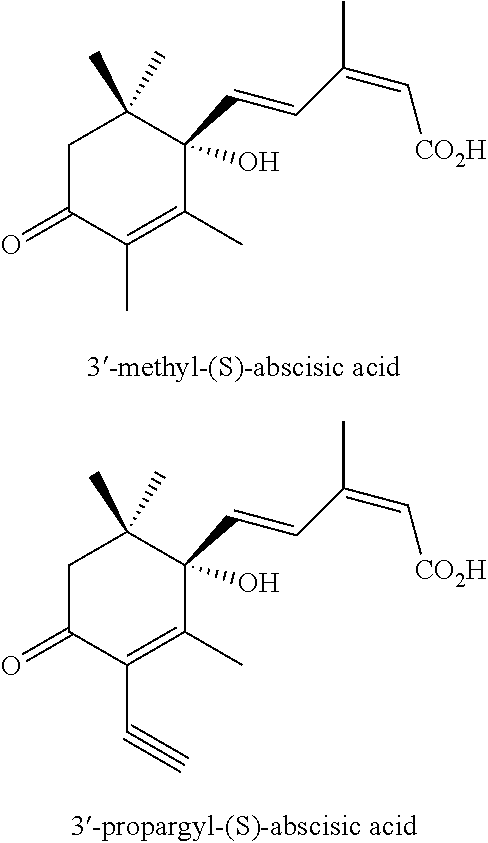(s)-abscisic acid derivatives for improving plant stress tolerance
- Summary
- Abstract
- Description
- Claims
- Application Information
AI Technical Summary
Benefits of technology
Problems solved by technology
Method used
Image
Examples
example 1
Cucumber Seedling Chilling
[0048]In these studies, 3′-methyl-(S)-abscisic acid was compared with (S)-abscisic acid on cucumber seedlings for prevention of chilling damage. Cucumber plants cv. ‘Straight Eight’ were grown for two weeks at 25° C. and were size matched into groups of three plants. Each group was sprayed with water+0.05% non-ionic surfactant (control), 100 ppm 3′-methyl-(S)-abscisic acid and surfactant, or 100 ppm S-ABA and surfactant until wet, respectively. For the spray solutions, 3′-methyl-(S)-abscisic acid was dissolved in 0.5% by volume DMSO in water.
[0049]Following the foliar treatment, plants were held for 48 hours at room temperature, then subjected to 4° C. for 96 hours, and then returned to 25° C. After the plants had been allowed to recover from the chilling treatments for 48 hours, the plants were rated for percent leaf area affected and new growth. Applicant found the plants treated with 3′-methyl-(S)-abscisic acid showed less damage and were more vigorous c...
example 2
Tobacco Plants Drought Assay
[0051]Tobacco plants cv. Xanthi-nc were grown for six weeks at 25° C. and were size matched into groups of four. Each plant group was drench-treated with 10 mL of water containing 0.5% DMSO (control), 0.3 mg, 1.0 mg or 3.0 mg / plant 3′-methyl-(S)-abscisic acid, or 0.3 mg, 1.0 mg or 3.0 mg / plant S-ABA, respectively. The plants were kept in the greenhouse and not watered, simulating drought conditions. After 18 days of water withdrawal, the plants in all treatment groups wilted. At that point, all the plants were watered again. The number of plants that wilted during each day of water withdrawal and the number of plants that recovered following the re-watering were recorded.
TABLE 2Effect of S-ABA or 3′-methyl-(S)-ABA on tobacco plantssubjected to droughtPercent of non-wiltedPercent ofplans on days after drench treatmentplantsand drought initiationrecovered 3DayDayDayDayDaydays after re-TreatmentDay 81012141618wateringControl100%83%0%0%0%0%0%S-ABA100%100%17%0...
example 3
Corn Plant Chilling
[0053]Corn seeds of a 111 day, central corn belt variety were planted in 2-quart pots filled with medium. After the corn grew for 10 days in the greenhouse at 24±3° C. (V2 to V3 growth stage), the plants received a foliar spray application of aqueous solutions of the test compounds containing 0.25% non-ionic surfactant with a volume equivalent to 30 gallons / acre. After spraying, plants were moved back to the greenhouse for 2 days, then moved to a growth chamber kept at 10° C. with a 16:8 light:dark cycle (cold treatment). After 5 days in the cold, plants were returned to the greenhouse for 2 days before being harvested destructively. Results of the studies comparing the growth rate of plants treated with S-ABA with 3′-methyl-(S)-ABA during the experiment are shown in Table 3.
TABLE 3Effect of S-ABA or 3′-methyl-(S)-ABA on growth rate of cornbefore, during and after chilling at 10° C.Growth Rate (cm / day)GrowthGreenhouseChamber0-2 d10° C.GreenhouseTRTpost2-7 d post7-...
PUM
 Login to view more
Login to view more Abstract
Description
Claims
Application Information
 Login to view more
Login to view more - R&D Engineer
- R&D Manager
- IP Professional
- Industry Leading Data Capabilities
- Powerful AI technology
- Patent DNA Extraction
Browse by: Latest US Patents, China's latest patents, Technical Efficacy Thesaurus, Application Domain, Technology Topic.
© 2024 PatSnap. All rights reserved.Legal|Privacy policy|Modern Slavery Act Transparency Statement|Sitemap

